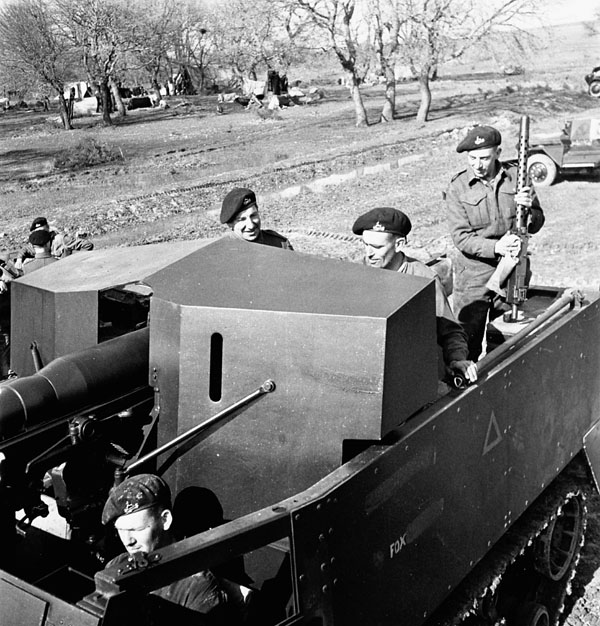SECOND WORLD WAR, WWII
THE BEGINNING OF MECHANIZATION
In the early hours of September 1, 1939, Hitler’s Panzers rolled across the Polish frontier thrusting The Royal Canadian Dragoons into another world war.
The Regiment was placed on active service in September 1939 and sent one squadron in 1940 to the 1st Canadian Cavalry Regiment (Mechanized). Later, the Regiment was again reorganized as a motorcycle regiment.
Early in 1941, it was again reorganized; this time as an armoured car regiment, and went overseas in November 1941. The black beret was officially adopted as the regimental headgear shortly before the Regiment left Canada in November 1941.
The Regiment was sent to Italy, however, it had no vehicles and fought as infantry for a month, holding the bank of the Anielli River. Resuming the armoured car role, it took part in the Liri Valley offensive as the reconnaissance regiment of 1st Canadian Corps. The Regiment led the advance up the Italian boot and won seven new Battle Honours.


The Regiment was also involved in the break through of the Hitler Line in May 1944 (as part of the 1st Canadian Infantry Division) and later the Gothic Line on 12 September 1944.
From 3 December 1944 until mid January 1945, the Regiment once again became infantry.
In the spring of 1945, the Regiment was transferred from Italy to North West Europe where it joined 2nd Canadian Corps in forming 1st Canadian Army. It was not until this time that it was used to its full advantage as an armoured car regiment, employing vehicles such as the Dingo, Staghound, Humber, and Greyhound and making a spectacular sweep from the Rhine to the North Sea. In this action the Dragoons collected 3500 prisoners and killed 1500 of the enemy.
During World War II, after extensive occupation by the German forces, on 15 April 1945, the Royal Canadian Dragoons, disobeying direct orders, charged into the heavily defended city of Leeuwarden and defeated the Germans, who were driven out by the next day. Thanks to a young woman in the town who still had a film camera., we have this footage of the day.
On 15th April 1945, the Dragoons liberated the city of Leeuwarden, Holland. A, B, C, and D Squadrons were all involved in the liberation with a total of 177 prisoners being taken. This event is commemorated annually and we are still welcomed as liberators on each visit to this fine Dutch town.
Each year the Echardt Memorial Trophy is presented to the best Corporal in the Regiment. The origin of this award can be found in a Sicilian tragedy. Two lieutenants and 40 other ranks were involved in a route march when they came upon a coastal gun emplacement, which was booby trapped. On investigation the gun emplacement magazine exploded, killing one officer and severely burning several men. Lance Corporal R.S. Eckhardt, severely burned himself, ran ½ mile for help. He died the next day. For his gallantry he was awarded the British Empire Medal. Lance Corporal Eckhardt is buried in the Agira Canadian War Cemetery in Sicily. On 15 January 1946, the Regiment returned to Canada.
Second World War Veteran Don White speaks about his early days in the service (1943). Video Cpl Kevin Langille
The 15th of April 2020 is the 75th anniversary of the Liberation of the City of Leeuwarden. C Squadron of the Royal Canadian Dragoons were the first to enter the city, and were greeted as liberators and heroes.
